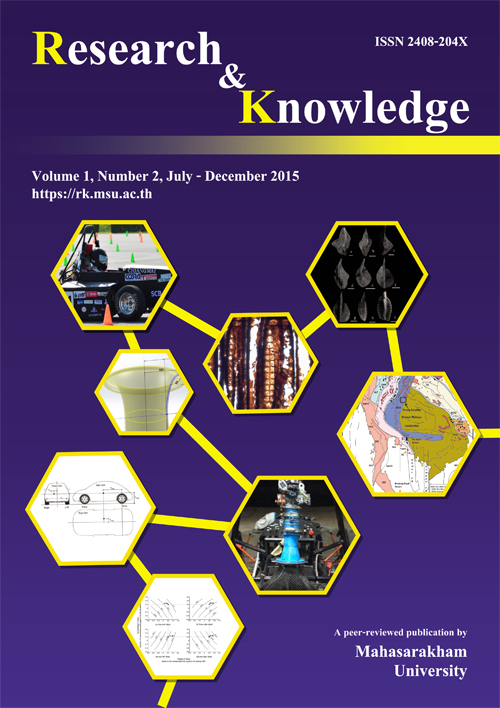Heat transfer characteristics of thermo-syphon: Case study of modifying inclination angle of evaporator and condenser sections
Keywords:
Thermosyphon, heat transfer characteristic, modify, inclination angleAbstract
Experiments were carried out to study the heat transfer characteristics of a thermosyphon when modifying the evaporator and condenser sections to be oriented at 0, 60 and 90 degrees with respect to the 70 degree inclination of the adiabatic section (Z shaped). The thermosyphon was made of copper tube with an outer diameter of 15.87 mm and 300, 450 and 600 mm total lengths. The evaporator, adiabatic and condenser sections were equal in length. R-134a, ethanol and distilled water were employed as the working fl uids with a 50% fi lling ratio by evaporator volume. The evaporator section was heated by hot water at 60, 70 and 80 o C, whereas 20 o C cool water was supplied to the condenser section. The test was conducted at various inclination angles, i.e., 0, 20, 40, 60, 70, 80, 90, 110, 130, 150, 170 and 180 degrees. The results show that the heat fl ux signifi cantly depends on the working temperature. R-134a had the best performance followed by ethanol and distilled water. The heat fl ux decreased with an increase in the total length. When increasing the orientation angles of the evaporator and condenser sections, the heat fl ux rose due to the assistance of gravity. The maximum heat fl ux was 26.85 kW/m2 with the lowest thermal resistance of 0.065 o C/W. In addition, the optimal tested orientation angle was in the range of 40-110 degrees with respect to the horizontal plane.
References
Cengel, Y. A. 2002. Heat transfer a practical approach. 2nd ed., McGraw-Hill, New York.
Fadhl, B., Wrobel, L. C. and Jouhara, H. 2013. Numerical modeling of the temperature distribution in a two-phase closed thermosiphon. Applied Thermal Engineering 60, 122-131.
Jiang, F., Chen, W. J., Liu, C. Z., Shi, J. T. and Li, X. L. 2014. Heat transfer enhancement in a three-phase closed thermosiphon. Applied Thermal Engineering 65, 495-501.
Jiao, B., Qiu, L. M., Zhang, X. B. and Zhang, Y. 2008. Investigation on the effect of fi lling ratio on the steady state heat transfer performance of a vertical two-phase closed thermosiphon. Applied Thermal Engineering 28, 1417-1426.
On-ai, K., Kummuang-lue, N., Terdtoon, P. and Sakulchangsatjatai, P. 2013. Effect of working fl uid types on thermal performance of vertical closed-loop pulsating heat pipe. The 5th International Conference on Science, Technology and Innovation for Sustainable Well-Being, Luang Prabang, Lao PDR.
Park, Y. J., Kang, H. K. and Kim, C. J. 2002. Heat transfer characteristics of a two phase closed thermosyphon to fi lling charge ratio. International Journal of Heat and Mass Transfer 45, 4655-4661.
Shabgard, H., Xiao, B., Faghri, A., Gupta, R. and Weissman, W. 2014. Thermal characteristics of a closed thermosyphon under various fi lling conditions. International Journal of Heat and Mass Transfer 70, 91-102.
Downloads
Published
How to Cite
Issue
Section
License

This work is licensed under a Creative Commons Attribution-NoDerivatives 4.0 International License.








